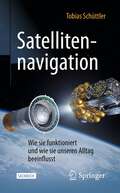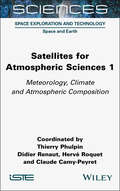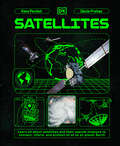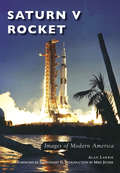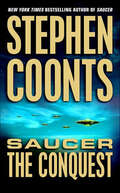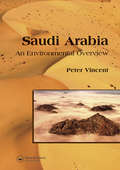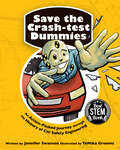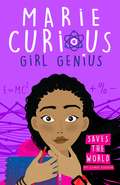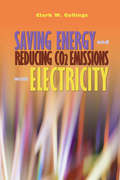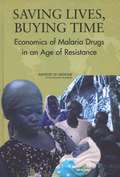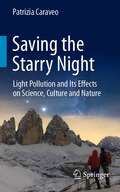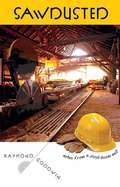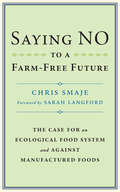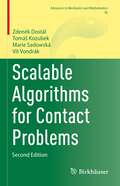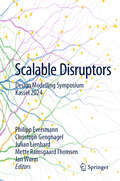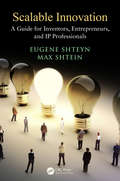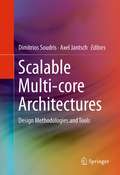- Table View
- List View
Satellitennavigation: Wie sie funktioniert und wie sie unseren Alltag beeinflusst (Technik im Fokus)
by Tobias SchüttlerFaszination Satellitennavigation – welche Rolle spielt sie im täglichen Leben? Wie funktioniert diese Technik? Was wäre, wenn GPS abgeschaltet würde? Und wie steht es um das europäische Galileo-System?In den vergangenen 20 Jahren hat sich die Satellitennavigation von einer anfangs rein militärischen Technologie hin zur vollkommen selbstverständlich genutzten Alltagstechnik entwickelt. Die Bandbreite reicht vom Navigationsgerät im Auto über Smartphones und kleine Empfänger für Outdoorsportler bis hin zu hochgenauen Spezialgeräten zum Zwecke der Landvermessung. Der Autor erläutert die im Prinzip sehr einfache Funktionsweise, welche jedoch in der konkreten Umsetzung modernste Methoden der Nachrichten- und Elektrotechnik, der Geographie und der Physik erfordert. In der zweiten Auflage wird verstärkt auf das europäische Galileo-System eingegangen und dessen aktueller Ausbaustand beschrieben.
Satellites for Atmospheric Sciences 1: Meteorology, Climate and Atmospheric Composition
by Claude Camy-Peyret Thierry Phulpin Didier Renaut Hervé RoquetHow can atmospheric variables such as temperature, wind, rain and ozone be measured by satellites? How are these measurements taken and what has been learned since the first measurements in the 1970s? What data are currently available and what data are expected in the future? The first volume of this encyclopedic book answers these questions by reporting the history of satellite meteorology and addresses how national and international agencies define coordinated programs to cover user needs. It also presents the principles of satellite remote sensing to deliver products suited to user requirements. This book is completed by a glossary and appendices with a list of supporting instruments already in use.
Satellites for Atmospheric Sciences 2: Meteorology, Climate and Atmospheric Composition
by Claude Camy-Peyret Thierry Phulpin Didier Renaut Hervé RoquetHow can atmospheric variables such as temperature, wind, rain and ozone be measured by satellites? How are these measurements taken and what has been learned since the first measurements in the 1970s? What data are currently available and what data are expected in the future? The second volume of this encyclopedic book presents each field of application – meteorology, atmospheric composition and climate – with its main aims as well as the specific areas which can be addressed through the use of satellite remote sensing. This book presents the satellite products used for operational purposes as well as those that allow for the advancement of scientific knowledge. The instruments that are at their origin are described, as well as the processing, delivery times and the knowledge they provide. This book is completed by a glossary and appendices with a list of supporting instruments already in use.
Satellites: Learn All About Satellites and Their Special Missions to Connect, Inform, and Protect All of US on Planet Earth (Adventures in Tech)
by Kate PeridotAn informative and beautiful guide to satellites for children.Satellites introduces children aged 7-9 to smart satellite technology and the ways satellites monitor the planet's health and help us take action.Every day, thousands of satellites orbit the Earth doing important jobs. Meet NOAA, Galileo, Aura, James Webb, and more, and find out about their special missions to connect, inform, and protect all of us on planet Earth.This science book for children offers: The start of a new series that combines space technology and earth science with elements of communication, conservation, and exploration.An inspiring book on the positive impact of technology in protecting and preserving our planet.A refreshing new perspective for space and technology curriculum activities that also explains how everyday tech works.Look up into a clear night sky and soon enough, you'll see a dot of light zip past. It’s not a shooting star, it's a satellite.The book uniquely combines Earth science and the latest space tech and is designed to fascinate and reassure. It includes a multitude of news-related themes: climate change, deforestation, wildlife tracking, storm/fire warnings, exploration, space junk, and more. There has never been a better time to learn about our 'eyes in the sky’.
Satoumi Science: Co-creating Social-Ecological Harmony Between Human and the Sea (Ecological Research Monographs)
by Tetsuo Yanagi Tetsu Sato Shinichiro KakumaThis book guides readers to the new concept of “Satoumi” and explains how its practice works to solve challenges in complex social-ecological systems of coastal areas. The book describes the significance of Satoumi Science as a transdisciplinary process. It starts with introducing the definition of Satoumi, highlights the important distinction between active measures (direct actions to improve ecosystem functions and services) and passive measures (a variety of management activities), and presents the concept of Integrated Local Environmental Knowledge (ILEK) as a knowledge base for Satoumi activities. It also introduces residential researchers and bilateral knowledge translators as the key actors of Satoumi co-creation through the transdisciplinary processes. The concept of Satoumi goes beyond the idea of protecting pristine nature by eliminating humans. It is about creating coastal environments where humans closely connect with the sea, which leads to the effective conservation and sustainable management of various natural resources and ecosystem services. This book will be of high interest to managers, governments, environmental groups, and the research community. Chapters cover current and emerging concerns, such as over- and under-use of natural resources, restoration of damaged ecosystems, and co-creation of new relations between humans and coastal seas, from transdisciplinary approaches to tackle with complex and 'wicked' challenges of coastal social-ecological systems.
Saturn V Rocket
by Alan Lawrie Mike Jetzer Ed Stewart IIIn 1961, Pres. John F. Kennedy set the challenge of landing a man on the moon by the end of the decade. In order to achieve this, NASA partnered with US industry to build the largest rocket ever produced, the Saturn V. It was designed and tested in record time and made its first flight in 1967. Less than two years later and within the timescales set by the president, the crew of Apollo 11 was launched on a Saturn V and watched live by millions of people on televisions around the world. From this launch, Neil Armstrong made his famous giant leap for mankind, later to be followed by 11 other astronauts who also walked on the moon.
Saturn V Rocket (Images of Modern America)
by Alan LawrieIn 1961, Pres. John F. Kennedy set the challenge of landing a man on the moon by the end of the decade. In order to achieve this, NASA partnered with US industry to build the largest rocket ever produced, the Saturn V. It was designed and tested in record time and made its first flight in 1967. Less than two years later and within the timescales set by the president, the crew of Apollo 11 was launched on a Saturn V and watched live by millions of people on televisions around the world. From this launch, Neil Armstrong made his famous giant leap for mankind, later to be followed by 11 other astronauts who also walked on the moon.
Saucer: Books 1-3: Saucer, Saucer: The Conquest, Saucer: Savage Planet (Saucer Ser. #2)
by Stephen CoontsThe sequel to Saucer by the New York Times–bestselling author—a “humorous UFO thriller . . . a gripping aerial duel of saucers up and down the East Coast” (Publishers Weekly).Rip Cantrell is brought back to give the saucer one last flight. Charlotte “Charley” Pine has started flying for a rich French tycoon, and there is believed to be another downed saucer somewhere in the area. Rip can’t quite get over the fact that Charley has dumped him. But when push comes to shove Rip and the United States Government are going to go head to head with this crazy Frenchman in trying to be the first to the saucer.As Stephen Coonts proved in his last outing, there is a great deal of high-flying adventure to be found in the Saucer series. And this one not only promises all the excitement of the last one, but it delivers with much, much more.Praise for Saucer“A comic, feel-good SF adventure.” —Kirkus Reviews“A flight of fancy . . . tough to put down.” —Publishers Weekly
Saudi Arabia: An Environmental Overview
by Peter VincentA comprehensive overview of Saudi Arabia‘s environment, this volume is a unique and authoritative text on the geological and environmental aspects of Saudi Arabia, a country about which little is known by the outside world. Saudi Arabia is a fascinating country with a long tradition of environmental awareness and sensitivity, pitted again
Save Our Freedom: A Wake-Up Call in Digital Times
by Bijan MoiniAbout the achievement of freedom - and how we willingly sacrifice it today. Freedom is something we take for granted—a fundamental human right we assume will always be there, and that we complain about vocally when we feel it&’s being upon. But in reality, the number of countries in which people can live freely is decreasing for the first time in decades. Bijan Moini&’s new book is a jarring wake-up call: if we aren&’t careful, our freedoms may be stripped away, too, and it might be our own fault. Vividly describing the current landscape of civil liberties in our capitalistic and digital age, Save Our Freedom! explains the immense importance the principle plays in our day-to-day, and outlines concrete actionable measures to fight back.
Save Our Freedom: A Wake-Up Call in Digital Times
by Bijan MoiniFreedom is something we take for granted—a fundamental human right we assume will always be there, and that we complain about vocally when we feel it's being upon. But in reality, the number of countries in which people can live freely is decreasing for the first time in decades. Bijan Moini's new book is a jarring wake-up call: if we aren't careful, our freedoms may be stripped away, too, and it might be our own fault. Vividly describing the current landscape of civil liberties in our capitalistic and digital age, Save Our Freedom! explains the immense importance the principle plays in our day-to-day, and outlines concrete actionable measures to fight back.. TIMELY, IMPORTANT, AND URGENT: The voluntary ceding of freedoms is an alarming and highly relevant issue facing our digital world, and one that we are not giving sufficient attention. Save Freedom is a call to action to change our focus before it's too late.
Save the Crash-test Dummies
by Jennifer SwansonJump in the driver's seat for this entertaining, STEM-filled tour of the history of car production and the science and engineering that makes cars safe.Cars take us to work. To school. To soccer practice. To the grocery store and home again. Can you imagine a world without them? It's not so easy!One of the reasons we can use cars so much in our everyday lives is because they are safe to drive. But that hasn't always been the case. If it weren't for the experiments conducted over decades that involved all kinds of crash test volunteers―dead, alive, animal, or automated―cars as we know them might not be around. And then how would you get to school?Filled with historical photographs, graphics and humorous illustrations, this nonfiction book from science educator and award-winning author Jennifer Swanson will appeal to lovers of all things that go and readers who are interested in getting under the hood and seeing how things work.
Saves the World: Book 1 (Marie Curious, Girl Genius #1)
by Chris Edison50% Girl power + 50% Genius = 100% Awesome! A brilliant new series with a heroine who uses her science smarts - and her girl squad - to save the world from evil, one invention at a time.Young inventor Marie can't believe her luck - she's spending her summer holidays in California, at the high-tech headquarters of Vance Corps! She and the other super-clever campers get to build robots, do super-cool science experiments and test out awesome gadgets. But not everyone is a happy camper . . .Someone is sabotaging their robots, so Marie and her new friends team up to catch the culprit. Can Marie outsmart an evil engineer intent on causing a global disaster?
Saving Energy and Reducing CO2 Emissions with Electricity
by Clark GellingsThrough different applications, electricity provides the energy required for light, heat, comfort, and mechanical work. In order to sustain society's expectation for comfort, convenience and productivity, it will remain necessary to continue to seek and find reasonable quantities of energy in forms which are accessible, affordable and have modest or zero environmental impacts. This in turn will call for an international imperative to make existing uses of electricity both efficient and practical. This book will guide the reader toward a clearer vision of that goal, with explanations of the concept of electrification, along with CO2 reductions through expanded end-use applications of electricity. Topics will include electric cars; airport, seaport, railroad and mining electrification; industrial uses of electricity in a variety of processes; residential building use of electricity; and enhancing energy efficiency and demand response.
Saving Lives, Buying Time: Economics of Malaria Drugs in an Age of Resistance
by Institute of Medicine of the National AcademiesFor more than 50 years, low-cost antimalarial drugs silently saved millions of lives and cured billions of debilitating infections. Today, however, these drugs no longer work against the deadliest form of malaria that exists throughout the world. Malaria deaths in sub-Saharan Africa—currently just over one million per year—are rising because of increased resistance to the old, inexpensive drugs. Although effective new drugs called “artemisinins” are available, they are unaffordable for the majority of the affected population, even at a cost of one dollar per course. Saving Lives, Buying Time: Economics of Malaria Drugs in an Age of Resistance examines the history of malaria treatments, provides an overview of the current drug crisis, and offers recommendations on maximizing access to and effectiveness of antimalarial drugs. The book finds that most people in endemic countries will not have access to currently effective combination treatments, which should include an artemisinin, without financing from the global community. Without funding for effective treatment, malaria mortality could double over the next 10 to 20 years and transmission will intensify.
Saving Science Class: Why We Need Hands-on Science to Engage Kids, Inspire Curiosity, and Improve Education
by Christopher McgowanMuch of what our students are learning about science in school bears little resemblance to real science. That is the main theme of this critique of science education by a veteran scientist and former school teacher. The author charges that today's teaching mandate has been taken over by educational specialists, people with little or no understanding of science. They clutter curricula with extraneous material, like engineering and technology, and focus so much attention theorizing over hypotheses and models and categorizing everything, that no time remains for doing science. There is little to entice youngsters to the science classroom today. McGowan emphasizes that the problem is not the teachers but the materials they are obliged to teach. He is especially critical of the widely influential "Next Generation Science Standards" (NGSS). This is based upon "A Framework for K-12 Science Education," which has been inordinately influenced by educational specialists. This is evident from the esoteric language, the almost exclusive citation of educational publications, and by glaring errors in science. The author urges a rethinking of science education to bring the focus back to conducting real hands-on science in the classroom. This approach was pioneered by the Nuffield Science Teaching Project in the UK, where working scientists acted as resource personnel for teachers designing curricula. Given the catastrophic problems facing planet Earth, scientific literacy has never been more important.From the Hardcover edition.
Saving the Starry Night: Light Pollution and Its Effects on Science, Culture and Nature
by Patrizia CaraveoThis book takes a close look at our relationship with the sky, the stars, light and darkness. In particular, it examines how light pollution has interfered with the culture of astronomy and our ability to appreciate this essential facet of our natural world. The sky has always held significance for humanity, in both cultural and scientific terms. And yet we persistently pollute it with (sometimes unnecessary) light in our obsessive desire to chase away the darkness. This effectively switches off the stars, hampering our ability to enjoy one of the most inspiring sights nature has to offer to humankind. In addition, too much light is hazardous to both our health and that of the fauna and flora of this planet. This book also features a comprehensive look at the current controversy regarding efforts to expand internet access through the launch into low Earth orbits of thousands of new satellites, which will pollute the night with moving lights while filling to saturation the capability of the circumterrestrial space. This conflict does not mean that the interests of astronomy and those of space technology have to be at odds, and potential compromises are explored between the satellite initiative and the desire to maintain a dark, radio silent sky.
Sawdusted: Notes from a Post-Boom Mill
by Raymond GoodwinWhen Raymond Goodwin started work at a Michigan sawmill in 1979, the glory days of lumbering were long gone. But the industry still had a faded glow that, for a while, held him there. InSawdustedGoodwin wipes the dust off his memories of the rundown, nonunion mill where he toiled for twenty months as a two-time college dropout. Spare, evocative character sketches bring to life the personalities of his fellow millworkers-their raucous pranks, ribbing, complaints about wages and weather, macho posturing, failed romances, and fantasies of escape. The result is a mostly funny, sometimes heartbreaking portrait of life in the lumbering industry a century after its heyday. Amidst the intermittent anger and resignation of poorly paid lumbermen in the Great Lakes hinterlands, Goodwin reveals moments of vulnerability, generosity, and pride in craftsmanship. It is a world familiar, in its basic outlines, to anyone who has ever done manual labor. At the heart of the book is a coming-of-age story about Goodwin’s relationship with his older brother Randy-a heavy drinker, chain smoker, and expert sawyer. Gruff but kind, Randy tutors Raymond in the ways of the blue-collar world even as he struggles with the demons that mask his own melancholy. A 2010 Michigan Notable Book
Saying NO to a Farm-Free Future: The Case For an Ecological Food System and Against Manufactured Foods
by Chris Smaje“Everyone in the food business needs to read this book. . . . [A] lively and superbly written polemic.”—Joel Salatin, co-founder of Polyface Farm A defense of agroecological, small-scale farming and a robust critique of an industrialized future. One of the few voices to challenge The Guardian's George Monbiot on the future of food and farming (and the restoration of nature) is academic, farmer and author of A Small Farm Future Chris Smaje. In Saying NO to a Farm-Free Future, Smaje presents his defense of small-scale farming and a robust critique of Monbiot’s vision for an urban and industrialized future. Responding to Monbiot’s portrayal of an urban, high-energy, industrially manufactured food future as the answer to our current crises, and its unchallenged acceptance within the environmental discourse, Smaje was compelled to challenge Monbiot’s evidence and conclusions. At the same time, Smaje presents his powerful counterargument – a low-carbon agrarian localism that puts power in the hands of local communities, not high-tech corporates. In the ongoing fight for our food future, this book will help you to understand the difference between a congenial, ecological living and a dystopian, factory-centered existence. A must-read! "Chris Smaje has laid down an indictment – as unremitting as it is undeniable – that cuts through the jargon-filled, techno-worshipping agricultural futurists who promise silver-bullet fixes for having your cake and eating it too. This brilliant and compelling book is at once hopeful and persuasive about the future of food."—Dan Barber, chef at Blue Hill and author of The Third Plate
Scaffolding In Tissue Engineering
by Peter X. Ma Jennifer ElisseeffThe growing interest in scaffolding design and increasing research programs dedicated to regenerative medicine corroborate the need for Scaffolding in Tissue Engineering. While certain books and journal articles address various aspects in the field, this is the first current, comprehensive text focusing on scaffolding for tissue engineering.
Scalability, Density, and Decision Making in Cognitive Wireless Networks
by Preston MarshallThis cohesive treatment of cognitive radio and networking technology integrates information and decision theory to provide insight into relationships throughout all layers of networks and across all wireless applications. It encompasses conventional considerations of spectrum and waveform selection and covers topology determination, routing policies, content positioning and future hybrid architectures that fully integrate wireless and wired services. Emerging flexibility in spectrum regulation and the imminent adoption of spectrum-sharing policies make this topic of immediate relevance both to the research community and to the commercial wireless community. • Features specific examples of decision-making structures and criteria required to extend network density and scaling to unprecedented levels • Integrates sensing, control plane and content operations into a single cohesive structure • Provides simpler and more powerful models of network operation • Presents a unique approach to decision-making and to mechanisms for adjusting control plane activity to ensure network scaling • Generalises the concepts of shared and adaptive spectrum policies • Addresses network transport operations and dynamic management of cognitive wireless networks' own information seeking behaviour
Scalable Algorithms for Contact Problems (Advances in Mechanics and Mathematics #36)
by Tomáš Kozubek Zdeněk Dostál Marie Sadowská Vít VondrákThis book presents a comprehensive treatment of recently developed scalable algorithms for solving multibody contact problems of linear elasticity. The brand-new feature of these algorithms is their theoretically supported numerical scalability (i.e., asymptotically linear complexity) and parallel scalability demonstrated in solving problems discretized by billions of degrees of freedom. The theory covers solving multibody frictionless contact problems, contact problems with possibly orthotropic Tresca’s friction, and transient contact problems. In addition, it also covers BEM discretization, treating jumping coefficients, floating bodies, mortar non-penetration conditions, etc. This second edition includes updated content, including a new chapter on hybrid domain decomposition methods for huge contact problems. Furthermore, new sections describe the latest algorithm improvements, e.g., the fast reconstruction of displacements, the adaptive reorthogonalization of dual constraints, and an updated chapter on parallel implementation. Several chapters are extended to give an independent exposition of classical bounds on the spectrum of mass and dual stiffness matrices, a benchmark for Coulomb orthotropic friction, details of discretization, etc. The exposition is divided into four parts, the first of which reviews auxiliary linear algebra, optimization, and analysis. The most important algorithms and optimality results are presented in the third chapter. The presentation includes continuous formulation, discretization, domain decomposition, optimality results, and numerical experiments. The final part contains extensions to contact shape optimization, plasticity, and HPC implementation. Graduate students and researchers in mechanical engineering, computational engineering, and applied mathematics will find this book of great value and interest.
Scalable Disruptors: Design Modelling Symposium Kassel 2024
by Christoph Gengnagel Mette Ramsgaard Thomsen Jan Wurm Philipp Eversmann Julian LienhardThis book reflects and expands on current trends in the Architecture, Engineering and Construction (AEC) industries as they respond to the unfolding climate and biodiversity crisis. Shifting away from the traditional focuses, which are narrowly centered on efficiency, this book presents a variety of approaches to move the AEC community from a linear, extractive paradigm to circular and regenerative one. The book presents contributions including research papers and case studies, providing a comprehensive overview of the field as well as perspectives from related disciplines, such as computer science, biology and material science.
Scalable Innovation: A Guide for Inventors, Entrepreneurs, and IP Professionals
by Eugene Shteyn Max ShteinInnovation is a primary source of economic growth, and yet only one idea out of 3,000 becomes a successful product or service. Scalable Innovation: A Guide for Inventors, Entrepreneurs, and IP Professionals introduces a model for the innovation process, helping innovators to understand the nature and timing of opportunities and risks on the path to
Scalable Multi-core Architectures
by Dimitrios Soudris Axel JantschAs Moore's law continues to unfold, two important trends have recently emerged. First, the growth of chip capacity is translated into a corresponding increase of number of cores. Second, the parallelization of the computation and 3D integration technologies lead to distributed memory architectures. This book describes recent research that addresses urgent challenges in many-core architectures and application mapping. It addresses the architectural design of many core chips, memory and data management, power management, design and programming methodologies. It also describes how new techniques have been applied in various industrial case studies.
